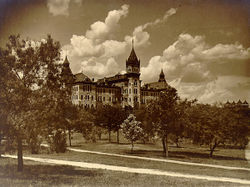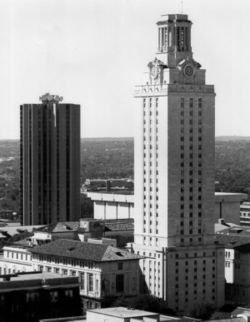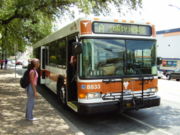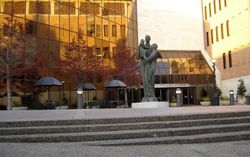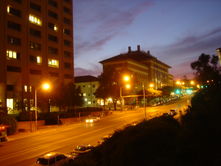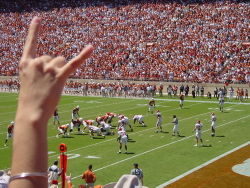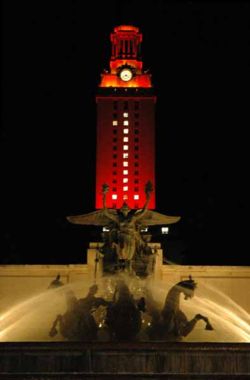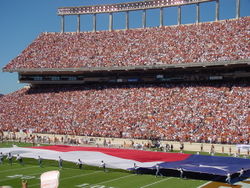University of Texas at Austin
2007 Schools Wikipedia Selection. Related subjects: North American Geography
 |
|
| Motto | Disciplina praesidium civitatis (Latin: Education, the Guardian of Society) |
|---|---|
| Established | 1883 |
| Type | Flagship state university |
| Endowment | $5.54 billion |
| President | William C. Powers, Jr. |
| Provost | Stephen Monti |
| Staff | 2,721 |
| Undergraduates | 36,878 |
| Postgraduates | 12,818 |
| Location | Austin, Texas, USA |
| Campus | Urban, 350 acres (1.4 km²) |
| Colors | Burnt orange and white |
| Mascot | |
| Website | www.utexas.edu |
| Logo is a trademark of The University of Texas | |
The University of Texas at Austin, often called UT or Texas, is the flagship institution of the University of Texas System. The main campus is located less than a mile from the Texas State Capitol in Austin. Founded in 1883, the university is considered to be a " Public Ivy," and had the fourth largest single-campus enrollment in the nation as of fall 2006 (and had the largest enrollment in the country from 1997–2003), with nearly 50,000 undergraduate and graduate students and 20,000 faculty and staff.
The university also operates various auxiliary facilities aside from the main campus, most notably the J.J. Pickle Research Campus. Texas is a major centre for academic research, annually exceeding $380 million in funding. In addition, the University's notable athletic programs were recognized by Sports Illustrated, which dubbed UT as "America's Best Sports College" in 2002. In January 2006, Texas won the Division I-A national football championship by beating the USC Trojans in the Rose Bowl.
UT has a network of over 450,000 living alumni, one of the largest of any American university.
History
The first mention of a public university in Texas can be traced to the 1827 constitution for the Mexican state of Coahuila y Texas. Although an article promised to establish public education in the arts and sciences, no action was ever taken by the Mexican government. After Texas gained its independence from Mexico in 1836, the Congress of Texas adopted the Constitution of the Republic, which included a provision to establish public education in republic, including two universities or colleges. On January 26, 1839, Congress agreed to eventually set aside fifty leagues of land towards the effort; in addition, forty acres in the new capital of Austin were reserved and designated "College Hill".
In 1846, Texas was annexed into the United States. The state legislature passed the Act of 1858, which set aside $100,000 in United States bonds towards construction. In addition, the legislature designated land, previously reserved for the encouragement of railroad construction, toward the universities' fifty leagues. However, Texas's secession from the Union and the American Civil War prevented further action on these plans.
After the war, the Texas Constitution of 1866 mandated that the state establish a university "at an early day." The passing of the Morrill Act in 1862 facilitated the creation of Texas A&M University, which was established in 1871 as the Agricultural & Mechanical College of Texas. During the construction of Texas A&M, the Texas Constitution of 1876 called for the creation of a "university of the first class," The University of Texas. It revoked the endowment of the railroad lands of the Act of 1858 but appropriated one million acres (4000 km²) in West Texas. In 1883, another two million were granted, with income from the sale of land and grazing rights going to The University of Texas and Texas A&M.
In 1881, Austin was chosen as the site of the main university, and Galveston was designated the location of the medical department. On the original "College Hill," an official ceremony began construction on what is now referred to as the old Main Building in late 1882. The university opened its doors on September 15, 1883.
The old Victorian- Gothic Main Building served as the central point of the campus's forty acre site, and was used for nearly all purposes. However, by the 1930s, discussions rose about the need for new library space, and the Main Building was razed in 1934 over the objections of many students and faculty. The modern-day tower and Main Building were constructed in its place.
Constitutional restrictions against funding building construction hampered expansion. However, the funds generated by oil discovered on university-owned grounds in 1923 were put towards its general endowment fund. This extra revenue allowed the university to pay down its debt, and pass bond in 1931 and 1947, funding the necessary expansion after the enrollment spike following World War II. The university built 19 permanent structures between 1950 and 1965, when it was given the right of eminent domain. With this power, the university purchased additional properties surrounding the original forty acres.
On August 1, 1966, Charles Whitman, an architectural engineering major at the university, barricaded himself in the observation deck of the tower of the Main Building with a sniper rifle and various other weapons. In a 96-minute stand-off, Whitman killed 15 people and wounded many more . Following the incident, the observation deck was closed until 1968 and closed again in 1975 following a series of suicide jumps. In 1998, after the installation of security and safety measures, the observation deck reopened to the public.
Campus
Today, the university encompasses about 350 acres (1.4 km²) on its main campus adjacent to downtown Austin and about 850 acres (3.4 km²) overall, including the J.J. Pickle Research Campus in north Austin and other properties in Austin and throughout Texas.
One of the university's most visible features is the Main Building, including a 307-foot tower designed by Paul Philippe Cret. Completed in 1937, the Main Building is located in the middle of campus. The tower usually appears illuminated in white light in the evening but is lit orange for various special occasions, including athletic victories and academic accomplishments, such as commencement. The tower is darkened for solemn occasions. At the top of the tower is a carillon of 56 bells, the largest in Texas. Songs are played on weekdays by resident carillonneur Tom Anderson, in addition to the usual pealing of Westminster Quarters every quarter hour between 6 AM and 9 PM.
The university is home to seven museums and seventeen libraries, which hold over eight million volumes. The holdings of the university's Harry Ransom Humanities Research Centre include one of only twenty-one remaining complete copies of the Gutenberg Bible worldwide and the world's earliest-known photograph: View from the Window at Le Gras taken by Nicéphore Niépce. On April 29, 2006, the Blanton Museum of Art opened. The 155,000 square foot (14,000 m²) museum hosts approximately 17,000 works from Europe, the United States, and Latin America.
The university also contains an extensive underground tunnel system that links many of the buildings. The tunnel system is closed to the public and is guarded by silent alarms. The tunnels are used for communications and utility service.
The university operates a 1.1 megawatt nuclear reactor at the J.J. Pickle Research Campus. The university's first reactor went critical, at Taylor Hall on the main campus, in August 1963 at 10 kW using fuel loaned from the U.S. Government. This reactor was upgraded to 250 kW in 1968. In the late 1980s, the university began work on the reactor for the Nuclear Engineering Teaching Lab at the Pickle Campus. This reactor went critical in 1992, despite local news reports on its safety.
The university continues to expand facilities on the campus. In February 2006, the Board of Regents voted to update and expand the football stadium. On March 2, 2006, the student body passed a referendum to build a new Student Activities Centre next to Gregory Gym on the east side of campus, pending final approval by the Board of Regents. According to The Daily Texan, the project is estimated to cost $51 million and is set to open between fall 2010 and fall 2012. Funding will primarily come from students, raising tuition by a maximum of $65 per semester.
Other notable facilities of the university include:
- McDonald Observatory, Jeff Davis County, Texas
- Marine Science Institute, Port Aransas, Texas
- J.J. Pickle Research Campus
- Centre for Space Research
- Innovation, Creativity and Capital (IC²) Institute
- Montopolis Research Centre
- Winedale Historical Centre, Round Top, Texas
- Bee Cave Research Centre
- Sam Rayburn Library, Bonham, Texas
- Institute of Geophysics
The university operates a public radio station, KUT, which provides local FM broadcasts as well as live streaming audio over the Internet. The university uses Capital Metro to provide bus transportation for students around the campus and throughout Austin.
Academic profile
The university contains 16 colleges and academic units, each listed with its founding date:
- School of Architecture (1951)
- McCombs School of Business (1922)
- College of Communication (1965)
- College of Education (1905)
- College of Engineering (1894)
- College of Fine Arts (1938)
- Graduate Studies (1910)
- School of Information (1948)
- Jackson School of Geosciences (2005)
- School of Law (1883)
- LBJ School of Public Affairs (1970)
- College of Liberal Arts (1883)
- College of Natural Sciences (1883)
- School of Nursing (1976)
- College of Pharmacy (1893 in Galveston, moved to Austin 1927)
- School of Social Work (1950)
More than 100 undergraduate and 170 graduate degree plans are offered. In the 2003-2004 academic year, the University awarded a total of 13,065 degrees. Bachelor's degrees comprised 68.6% of this total, master's degrees 21.7%, doctoral degrees 5.2%, and other professional degrees 4.5%.
UT has numerous undergraduate honours programs, such as Business Honours and Plan II, that attract students from around the state, nation, and even the world.
Rankings
In 2006, The Washington Monthly, using a ranking system which stresses social factors the magazine considers important (such as percentage of students in ROTC and percentage of students on Pell grants) ranked UT Austin 17th among national American universities, higher than prestigious Ivy League universities such as Princeton and Harvard. The Times Higher Education Supplement listed the university as 26th out of the top 200 universities globally. Additionally, Texas was ranked as the 24th best university in the country and 36th best in the world by The Institute of Higher Education at Shanghai Jiao Tong University.
US News and World Report consistently ranks Texas as the best public university in the state of Texas. In its 2007 rankings, Texas places 47th among all national universities in the U.S.
The 2007 Princeton Review survey ranked the school the #1 party school in the nation. The school ranked second in the use of hard liquor, third in beer drinking and 13th in marijuana smoking in a survey of 115,000 students at campuses around the country. The survey also ranked the school sixth in the category "Their Students (Almost) Never Study".
UT Austin does not have a medical school, but has associated programs with other campuses and allied health professional programs on campus. The UT Austin Pharmacy School, for example, is nationally ranked 2nd in the United States.
Faculty and research
As of 2004, the university employed 2,271 faculty members. Approximately 51.1% were tenured, while an additional 17.8% were tenure track. The university's faculty includes winners of the Nobel Prize, the Pulitzer Prize, the National Medal of Science, the National Medal of Technology, and numerous other awards. Over 1,000 faculty positions are endowed by private funds. Since 1984, more than forty $1 million-endowed chairs have been created at The University of Texas to recruit distinguished faculty and facilitate research in the sciences and engineering.
The university exceeds $380 million in annual research funding, and its facilities house more than 90 research units. UT has earned more than 400 patents since its founding. In 2005, Texas secured $417 million in awards and grants, a new university record. In addition, Texas earned $5 million in licensing revenue and capped a six-year funding increase of 48%. The university has also reached out to establish partnerships with other facilities, including the University of Texas Medical Branch in Galveston, the University of Texas Health Science Centre, the Johnson Space Centre of the National Aeronautics and Space Administration, the Pacific Northwest National Laboratory, and the International Centre for Nanotechnology and Advanced Materials.
In addition to research in traditional fields, scientists are pushing forward in several new, interdisciplinary areas, including nanotechnology and materials engineering for next-generation semiconductors. In addition, Texas is advancing high performance computing through the Texas Advanced Computing Centre (TACC), which supports over 600 projects in the natural sciences, engineering, and business.
The university's library system ranks sixth among academic libraries in the nation with 7.5 million volumes. The main campus library is the Perry-Castañeda Library.
Endowment
The university receives income from an endowment known as the Permanent University Fund (PUF), with $11.6 billion ( fourth-largest in the United States) in assets as of November 2005, of which 30 percent is dedicated to the university. Proceeds from lands appropriated in 1839 and 1876, as well as oil monies, comprise the majority of this fund. At one time, the PUF was the chief source of income for Texas's two university systems, The University of Texas System and the Texas A&M University System; today, however, its revenues account for less than 10 percent of the universities' annual budgets. This has challenged the universities to increase sponsored research and private donations. Privately funded endowments contribute over $2 billion to the University's total endowment value.
Student life
The university enrolls 37,377 undergraduate, 11,533 graduate and 1,467 law students, coming from all 254 Texas counties. In addition, students from all 50 states and more than 100 foreign countries, most notably, the Republic of Korea, followed by India, the People's Republic of China, Mexico and Taiwan, are represented. The average SAT score for entering Fall 2004 freshmen was a 1230 out of 1600.
Housing
The campus is currently home to thirteen dormitories, with a fourteenth under construction and slated for opening in spring 2007. On-campus housing can hold more than 6,700 students. Jester Centre is the largest dormitory with its capacity of 2,945. Academic enrollment exceeds the capacity of on-campus housing; as a result, most students must live in private dormitories, housing cooperatives, apartments, or with Greek organizations and other off-campus residences. The Division of Housing and Food Service, which already has the largest market share of the estimated 27,000 beds in the campus area, plans to expand to 9,000 beds in the near future.
Student organizations
The university recognizes more than 1,000 student organizations. In addition, the University supports three official student governance organizations that represent student interests to faculty, administrators, and the Texas Legislature. Student Government represents student interests in general, the Senate of College Councils represents students in academic affairs and coordinates the college councils, and the Graduate Student Assembly represents graduate student interests.
Greek organizations
The Office of the Dean of Students' Greek Life and Education section administers more than 50 Greek organizations, and about 9% of men and 12% of women in the undergraduate class choose to join one of these groups. Other registered student organizations also name themselves with Greek letters, including the founding chapters of Beta Upsilon Chi, a national Christian fraternity, and Sigma Phi Lambda, a national Christian sorority.
School spirit
- School colors: The school's official colors are Orange and White, with Burnt Orange — also known as Texas Orange — being the specific shade of orange used.
- Alma mater: Its alma mater is " The Eyes of Texas."
- Fight song and "Hook 'em, Horns!" At football games, students frequently sing " Texas Fight", the University's fight song, while displaying the Hook 'em Horns hand gesture. The University of Texas Longhorn Band is also known as the Showband of the Southwest.
- Mascot: The school mascot is a Texas longhorn named Bevo.
Athletics
The University of Texas offers a wide variety of varsity and intramural sports programs. Due to the breadth of sports offered and the quality of the programs, Texas was selected as "America's Best Sports College" in a 2002 analysis performed by Sports Illustrated.
Varsity sports
The university's men's and women's athletics teams are nicknamed the Longhorns. A charter member of the Southwest Conference until its dissolution in 1996, Texas now competes in the Big 12 Conference (South Division) of the NCAA's Division I-A.
The University of Texas has traditionally been considered a college football powerhouse. The team experienced its greatest success under coach Darrell Royal, winning three National Championships in 1963, 1969, and 1970, and winning a fourth title under head coach Mack Brown in 2005 after the 41-38 defeat of previously undefeated (and top-ranked) USC in the Rose Bowl.
In recent years, the men's basketball team has gained prominence, advancing to the NCAA Tournament Sweet Sixteen in 2002, the Final Four in 2003, the Sweet Sixteen in 2004 and the Elite Eight in 2006.
The university's baseball team is considered one of the best in the nation with more trips to the College World Series than any other school, with wins in 1949, 1950, 1970, 1983, 2002 and 2005.
Rivalries
The university's major rival in almost every sport is generally considered to be Texas A&M University. The two schools have acknowledged the importance of this rivalry by creating the State Farm Lone Star Showdown series, which encompasses all sports where both schools field a varsity team. The football game played between the two schools is the third longest-running rivalry in the nation and is the longest-running rivalry for both schools. The game used to be played on Thanksgiving day but in recent years has been played on the day following Thanksgiving.
Many fans and observers, however, argue that the Longhorns' biggest rival in football is the University of Oklahoma. The football game between Texas and Oklahoma is known as the AT&T Red River Rivalry and is held annually in Dallas, Texas at the Cotton Bowl. This longstanding rivalry pits the populations of Texas and Oklahoma against one another in a bitter competition over state pride and bragging rights. In recent years, this rivalry has been particularly spirited, in part due to the fact that at least one school had been ranked in the top 5 nationally at the time of the game.
Many other schools also consider Texas among their biggest rivals.
Facilities
Major sporting facilities and their main use include:
- Darrell K. Royal-Texas Memorial Stadium — Football
- Frank Erwin Special Events Centre — Basketball
- UFCU Disch-Falk Field — Baseball
- Mike A. Myers Stadium — Soccer
- Red and Charline McCombs Field — Softball
- Gregory Gymnasium — Volleyball
- Lee and Joe Jamail Texas Swimming Centre — Swimming and Diving
- Penick-Allison Tennis Centre — Tennis
- Texas Rowing Centre — Rowing
In addition, the university has numerous practice, training, and intramural facilities.
Notable people
The university has a base of more than 450,000 living alumni. With strong academic programs in the sciences, arts, media, business, law, engineering, and public policy, as well as a successful athletics program, The University of Texas has seen many now notable persons pass through its halls.
